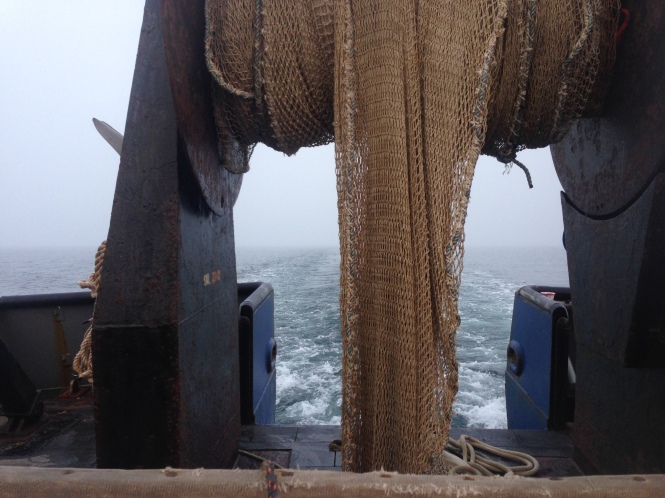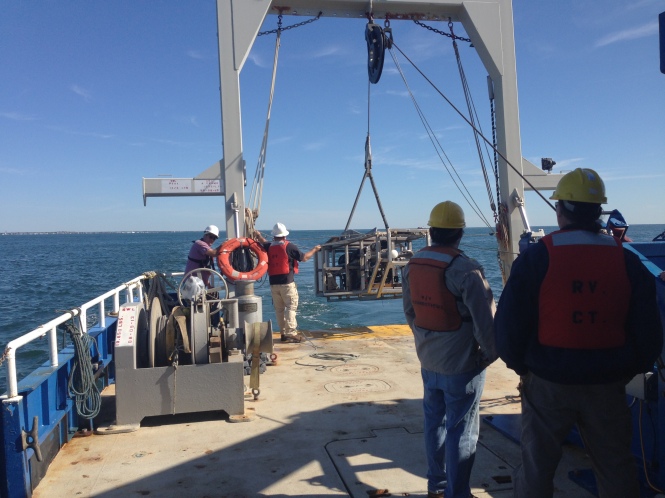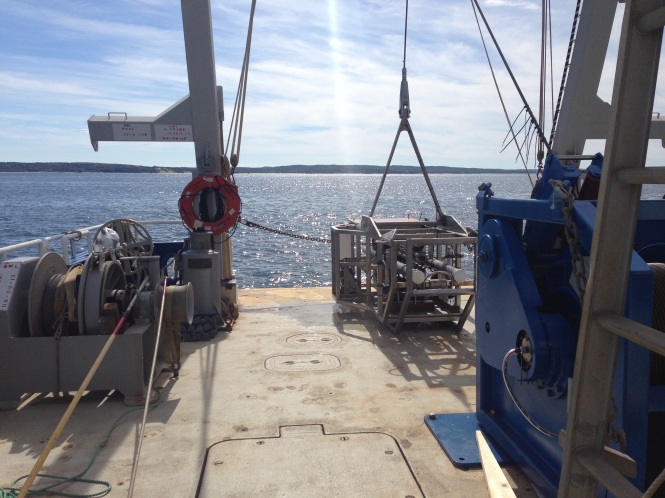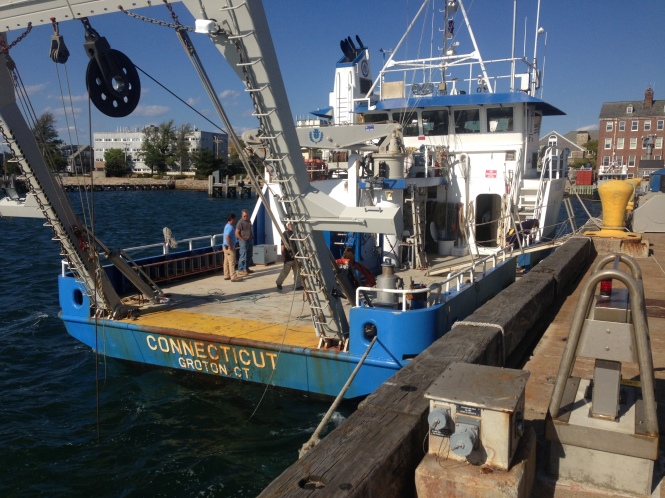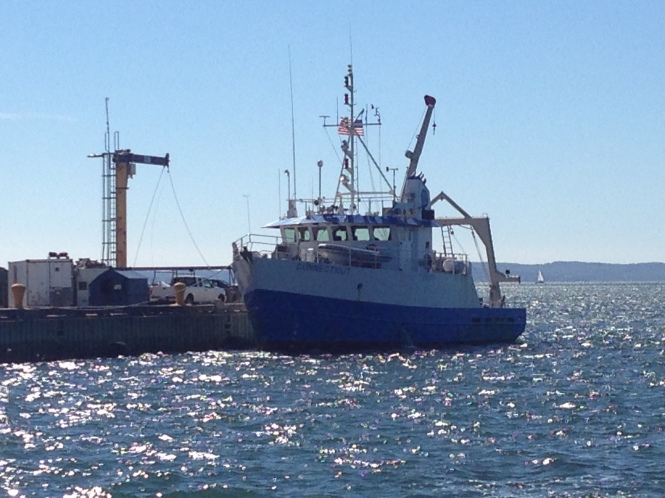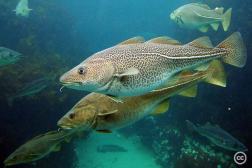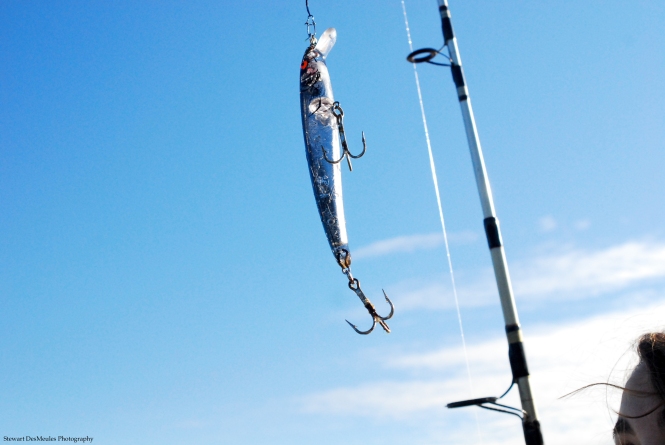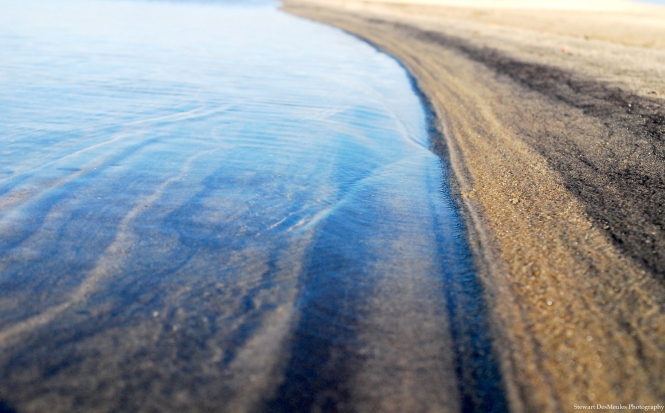Getting ready to set a trawl net on the R/V Gloria Michelle. This was part of a state survey of commercial fishing stocks off Cape Cod, MA.
New England Fisheries
R/V Connecticut, HABCAM Testing.
The University of Connecticut’s research Vessel being used to test a newly fabricated ‘HABCAM’. This robotic camera array will be used to capture the sea bottom in high resolution 3D images to be used to quantify a range of different species living on the bottom of the ocean. This HABCAM resides in Woods Hole, MA.
Trash Fish; The answer or the last resort?
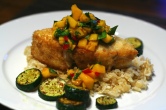 If you’re finding this article, you likely know what a ‘trash fish’ is. Trash fish can be defined in a few different ways, but the trash fish I’d like to refer to here are fish that were traditionally considered unpalatable, unfit for human consumption, or otherwise having no market value. There is a trend in commercial fishing today to move away from overfished species, and to start targeting fish that have previously had no market. This trend isn’t necessarily born out of a desire to move towards sustainable fisheries, but instead it’s born out of the fact that there aren’t enough traditional market fish left in the ocean to make a living on.
If you’re finding this article, you likely know what a ‘trash fish’ is. Trash fish can be defined in a few different ways, but the trash fish I’d like to refer to here are fish that were traditionally considered unpalatable, unfit for human consumption, or otherwise having no market value. There is a trend in commercial fishing today to move away from overfished species, and to start targeting fish that have previously had no market. This trend isn’t necessarily born out of a desire to move towards sustainable fisheries, but instead it’s born out of the fact that there aren’t enough traditional market fish left in the ocean to make a living on.
“History is repeating itself, and what’s needed is an overall reduction in fishing pressure, not just a move to fishing for different species.”
Fishermen, restaurants, seafood distributors, and some environmental groups are working to develop new markets for fish, and they’re trying to convince consumers that these new fish are both good to eat and environmentally friendly. These ‘trash species’ include fish like the Spiny Dogfish, Sea Robin, Monkfish, and skates. The shift towards these species will reduce fishing pressure on threatened species like the Atlantic Cod, but in turn, it will turn the bulk of commercial fishing effort onto these species which have traditionally not been targeted. With many scientists doubtful of how quickly the Atlantic Cod population can recover, or if it will ever fully recover, these trash fish species may be heavily targeted for many years to come. If our commercial fishing fleet is able to nearly eliminate one species from the ecosystem, there’s no question that it could do the same to another species.
The example I’ll focus on is the relationship between the Atlantic Cod and the Spiny Dogfish. On Cape Cod in Massachusetts, the Codfish is iconic. It gave the Cape its name and its reputation, fed millions, and seemed to be an inexhaustible resource. In the 1990’s however, the species crashed, hard. A 95% decline in biomass (based on historical records) was a sobering blow to the industry. The crash was largely the result of overfishing, especially from ruthless efficiency of new fishing technologies implemented in the 1960’s. Fisheries management was thrown into a whirlwind, and proposed cuts to quotas were met with fierce opposition from fishermen and those representing fishermen. What followed was years of back and forth between fisheries management, fisheries scientists, politicians, fishermen, and environmental groups. It took over 20 years, from the Cod crash in 1992 for officials to implement meaningful quota cuts. In late 2013, federal fisheries officials signed in 77% cuts in the Gulf of Maine cod fishery, and over 50% cuts in the quota for Georges Bank (off New England). With their traditional money maker off the table, commercial fishermen on Cape Cod have been working to rebrand trash fish species. The Spiny Dogfish is on the list. Prices for the fish are still low, but as high end restaurants and seafood distributors begin to market the fish, prices are bound to rise. If you Google “trash fish dinners” you’ll find all kinds of publicized events at restaurants touting the sustainability of these new fish. These dinners have become quite fashionable on the east coast. They’re marketed at times as a panacea for the negatives of overfishing and give the impression to the attendees that by being a part of expanding the market for these fish, they’re doing their part to save the ocean.
The truth about trash fish is that we’ve been employing this ‘fishing down the ecosystem’ strategy for centuries. Luxury seafoods like lobster and oysters were once fed to prisoners and slaves, only until their populations began dwindling did they become more expensive and gain their spot on the menus of high priced restaurants. Trash fish have been turned to over and over as populations of preferred fish have been depleted. The promoters of these trash fish are missing this very important point. History is repeating itself, and what’s needed is an overall reduction in fishing pressure, not just a move to fishing for different species.
Surf Casting, Cape Cod.
Ocean on the half shell.
Returning from a fishing voyage..
Talking Fish, The Conservation Law Foundation’s New England fisheries blog.
The Amazing Alewife
 The Alewife (Alosa pseudoharengus) or River Herring, is one of the most important anadromous fish in the coastal ecosystem. An anadromous fish is a fish that spends most of its life out in the ocean, but swims into freshwater bodies to spawn. These fish school by the thousands in mid-spring, coming from all directions searching for their spawning grounds. They make their way up turbulent, swelling spring rivers in search of calmer lakes and ponds to drop their eggs. This mass migration of fish into coastal fresh water bodies brings a huge nutrient influx to the local ecosytem. This food source is important for birds like eagles, osprey, herons, and gulls. Many mammals also take advantage of this influx, as these fish are easy pickings when they come to a bottleneck in a river or stream. Striped bass will also follow these fish up river and prey upon them as well.
The Alewife (Alosa pseudoharengus) or River Herring, is one of the most important anadromous fish in the coastal ecosystem. An anadromous fish is a fish that spends most of its life out in the ocean, but swims into freshwater bodies to spawn. These fish school by the thousands in mid-spring, coming from all directions searching for their spawning grounds. They make their way up turbulent, swelling spring rivers in search of calmer lakes and ponds to drop their eggs. This mass migration of fish into coastal fresh water bodies brings a huge nutrient influx to the local ecosytem. This food source is important for birds like eagles, osprey, herons, and gulls. Many mammals also take advantage of this influx, as these fish are easy pickings when they come to a bottleneck in a river or stream. Striped bass will also follow these fish up river and prey upon them as well.
This adapted anadromous behavior has been beneficial to the species for millenia, but it ran into problems when people began constructing mill dams along rivers throughout northeast coastline. Dams constructed along rivers to power sawmills had the unintended consequence of blocking millions of alewives access to their spawning grounds. Alewife populations quickly plumetted. Over the past 100 years, these mill dams have become obsolete, and many of them have been descontructed, restoring alewives access to spawning areas. These fish have very high fecundity, one female capable of laying 70,000 eggs in a season, and thus are quick to recover when given the opportunity. To learn more about the push for alewife restoration, counting efforts, and dam removal, visit the Herring Alliance.
Shellfish of the Week: Blue Crab (Callinectes sapidus)
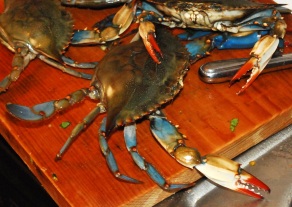 The Blue Crab is an icon of the Chesapeake Bay. It might get you thinking of fingers red with Old Bay seasoning, summer picnic tables covered in newspaper, bowls of melted butter and a good beer. Well, roll up your sleeves; brush the dust off your claw crackers and meat picks, because blue crab season is right around the corner. You can feel good about eating blue crab too. It’s currently not being overfished, and the stock is stable. This is important, considering it’s one of the most popular shellfish in the mid-atlantic. The biggest threat to a sustainable blue crab population is nutrient loading in spawning grounds. There has been an active push to clean up the Chesapeake for many years now, and lots of progress has been made. Bycatch in the blue crab fishery isn’t much of a concern either, as the way the crabs are caught allows fishermen to be very selective, usually pulling up only blue crab in their traps.
The Blue Crab is an icon of the Chesapeake Bay. It might get you thinking of fingers red with Old Bay seasoning, summer picnic tables covered in newspaper, bowls of melted butter and a good beer. Well, roll up your sleeves; brush the dust off your claw crackers and meat picks, because blue crab season is right around the corner. You can feel good about eating blue crab too. It’s currently not being overfished, and the stock is stable. This is important, considering it’s one of the most popular shellfish in the mid-atlantic. The biggest threat to a sustainable blue crab population is nutrient loading in spawning grounds. There has been an active push to clean up the Chesapeake for many years now, and lots of progress has been made. Bycatch in the blue crab fishery isn’t much of a concern either, as the way the crabs are caught allows fishermen to be very selective, usually pulling up only blue crab in their traps.
RECIPE:
The best way I’ve found to prepare blue crab is to steam them in a broth of Old Bay, beer, salt, and vinegar. Take a trip to your local seafood market and pick out a good slew of live blues.
Mix a 1/2 cup of Old Bay, 3 dark and flavorful beers, 2 cups distilled vinegar, and a 1/2 cup salt in a large pot and bring to a boil. Lay a steaming rack over just over the boiling mixture, and layer the crabs until the pot is full. I like to sprinkle each layer of crabs with a good dose of Old Bay. Steam for about 25 minutes until the crabs turn bright orange/red. Prep a table for getting messy by laying down some newspaper and ready a large bowl for shell discards. I like to mix melted butter, soy sauce and a little lemon in a bowl for dipping. Crack open a beer and dig in!
Bay Scallop
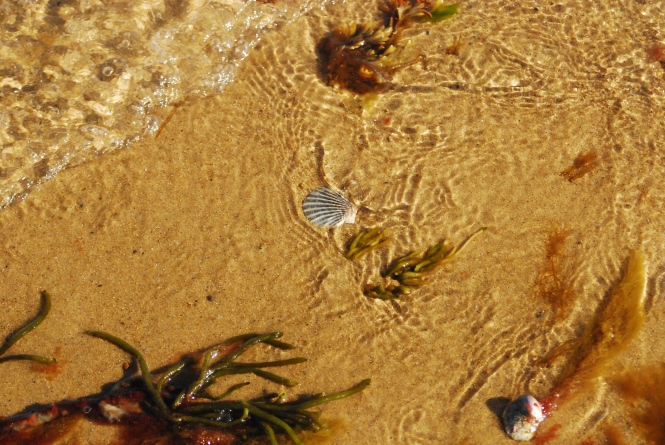
Bay Scallop, Cape Cod

